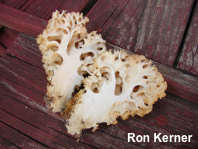|
The Genus Sparassis 
[ Basidiomycota > Polyporales > Sparassidaceae . . . ]
by Michael Kuo
Species of Sparassis are found in forests, where they are saprobes, usually associated with the roots of trees, creating a brown rot. Species of Sparassis are often referred to as "cauliflower mushrooms," but I have never really understood why, since they don't really resemble cauliflower heads very closely. I think they look like tightly packed clusters of noodles—curly egg noodles, or, in other species, larger, flattened noodles or elongated dumplings.
The most recent studies (Hughes et al. 2014, Petersen et al. 2015) indicate the presence of three North American species of Sparassis, with a few accompanying "forms." Identification is mostly accomplished with reference to ecology and range, and by observation of physical features, especially with regard to the shapes of the branches.
Sparassis crispa, the type species for the genus, turns out to be a strictly European species, associated with Scots pine. Previous North American descriptions of this species generally refer to Sparassis americana east of the Great plains and in the southwestern United States, or Sparassis radicata in the Pacific Northwest.
|
|



|
Key to 5 Sparassis species and varieties in North America 
| 1. | (Look-alike species: Flesh very tough and leathery; surfaces with a rugged, nearly corrugated texture; rare, distributed from South Carolina to southern Missouri and Brazil.) | |
| 1. | Flesh comparatively soft and more pliable; surfaces smooth; variously distributed. | 2 |
| 2. | Distributed from the Rocky Mountains westward; associated with conifers. | 3 |
| 2. | Distributed east of the Rocky Mountains; associated with conifers or hardwoods. | 4 |
| 3. | Associated with Ponderosa pine in the southwestern United States and southern California. | |
| 3. | Associated with spruces or Douglas-fir in the Pacific Northwest and northern California. | |
| 4. | Branches "noodly" in appearance, with curly or "crisped" margins; associated only with pines (species of Pinus, with bundled needles); surfaces not featuring zones of colors; clamp connections present in flesh. | |
| 4. | Branches less "noodly," relatively flat and straight; associated with oaks or pines; surfaces sometimes developing zones of color; clamp connections not found in flesh. | 5 |
| 5. | Tips of branches up to 1 mm thick at maturity; usually featuring zones of color; pinkish hues sometimes developing in older specimens. | |
| 5. | Branch tips 2–4 mm thick at maturity; usually not zoned; pinkish hues usually not present. | |
References
Blanco-Dios, J. B., Z. Wang, M. Binder & D. S. Hibbett (2006). A new Sparassis species from Spain described using molecular and morphological data. Mycological Research 110: 1227–1231.
Burdsall, H. H. & O. K. Miller (1988a). Type studies and nomenclatural considerations in the genus Sparassis. Mycotaxon 31: 199–206.
Burdsall, H. H. & O. K. Miller (1988b) Neotypification of Sparassis crispa. Mycotaxon 31: 591–593.
Coker, W. C. (1921). Notes on the Thelephoraceae of North Carolina. Journal of the Elisha Mitchell Scientific Society 36: 146–196.
Dai, Y. -C., Z. Wang, M. Binder & D. S. Hibbett (2006). Phylogeny and a new species of Sparassis (Polyporales, Basidiomycota): evidence from mitochondrial atp6, nuclear rDNA and rpb2 genes. Mycologia 98: 584–592.
Hughes, K. W., A. R. Segovia & R. H. Petersen (2014). Transatlantic disjunction in fleshy fungi. I. The Sparassis crispa complex. Mycological Progress 13: 407–427.
Light, W. Woehrel, M. (2009). Clarification of the nomenclatural confusion of the genus Sparassis (Polyporales: Sparassidaceae) in North America. Fungi 2: 10–15.
Martin, K. J. & R. L. Gilbertson (1976). Cultural and other morphological studies of Sparassis radicata and related species. Mycologia 68: 622–639.
Petersen, R. H., J. Borovička, A. R. Segovia & K. W. Hughes (2015). Transatlantic disjunction in fleshy fungi. II. The Sparassis spathulata-S. brevipes complex. Mycological Progress 14: 30.
Ryoo, R., H. -D. Sou, K. -H. Ka & H. Park (2013). Phylogenetic relationships of Korean Sparassis latifolia based on morphological and ITS rDNA characteristics. Journal of Microbiology 51: 43–48.
Wang, Z., M. Binder, Y. C. Dai & D. S. Hibbett (2004). Phylogenetic relationships of Sparassis inferred from nuclear mitochondrial ribosomal DNA and RNA polymerase sequences. Mycologia 96: 1015–1029.
Zhao, Q., B. Feng, Z. L. Yang, Y. -C. Dai, Z. Wang & B. Tolgor (2013). New species and distinctive geographical divergences of the genus Sparassis (Basidiomycota): evidence from morphological and molecular data. Mycological Progress 12: 445–454.
This site contains no information about the edibility or toxicity of mushrooms.
Cite this page as:
Kuo, M. (2021, June). The genus Sparassis. Retrieved from the MushroomExpert.Com Web site: http://www.mushroomexpert.com/sparassis.html
© MushroomExpert.Com
|



